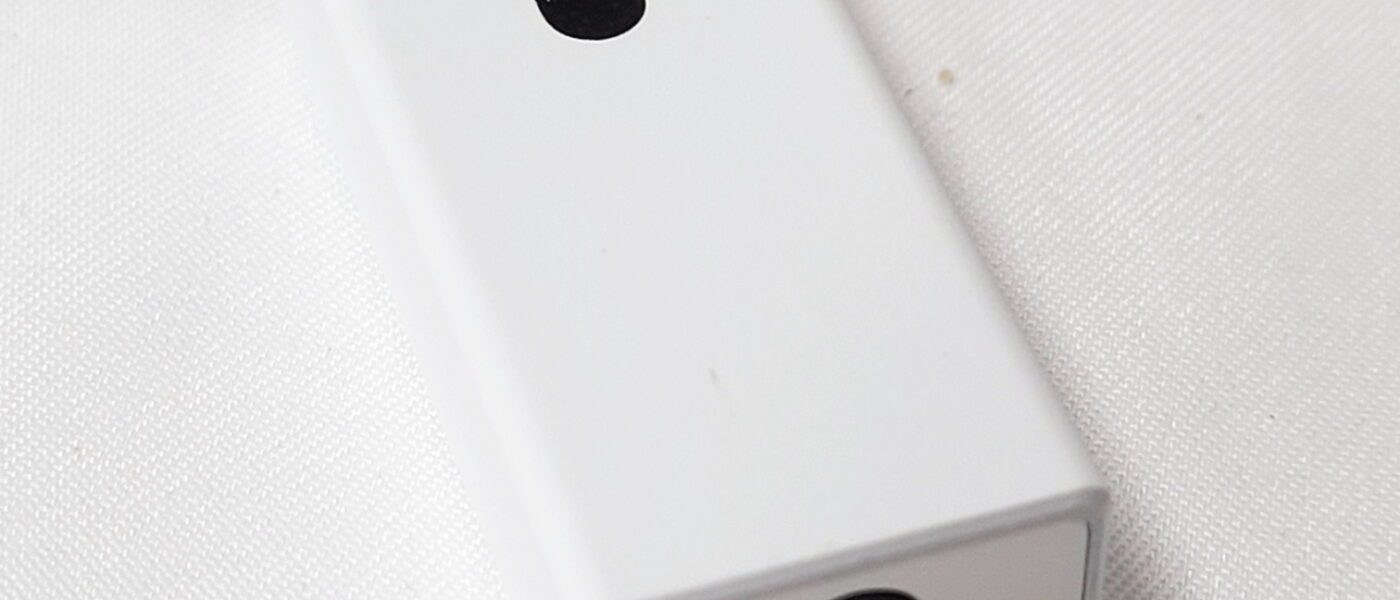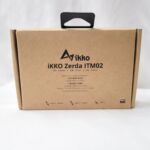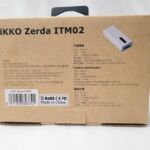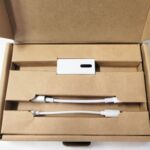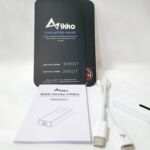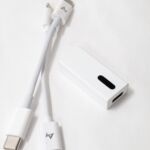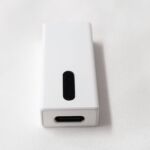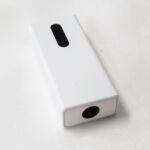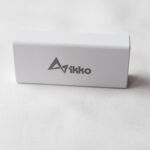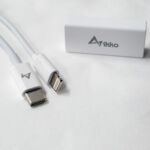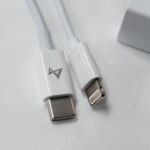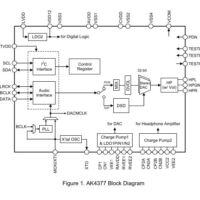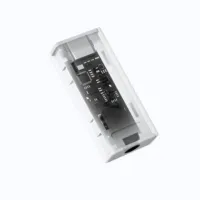IKKO Zerda ITM02
disclaimer: I was sent the ITM02 and the ITG01 from IKKO for review. I have reviewed several IKKO Products previously and always found them to be of good value, but I have no financial interest in IKKO or any of its partners or vendors and my review was not compensated other than the device itself. If you have an interest in the ITM02, more information can be found on IKKO website.
Unboxing/Packaging:
Don’t expect an upscale unboxing experience as IKKO spent all of their efforts on the contents and keeping the price down. The ITM02 ships in a plain brown cardboard package, but it does have nicely designed recesses for the device and cables to keep things from bouncing around in transit. The ITM02 ships with the unit itself and two4 inch cables, one each USB type-C male to male and USB type-C to lightning. lifting the cardboard tray out reveals a customer service card and manual that complete the package. At $59, we shouldn’t expect a ton of bells and whistles and the ITM02 ships with only what is needed. A carrying case would be a nice addition to keep up with the extra cable and to protect the kit when not in use, but at $59 we can forgive the lack of one.
Build:
The ITM02 itself is a tiny unit measuring 1.5 inches in length, 0.5 inches in width and only 0.25 inches in height. It is available only in a bright white and largely constructed of an aluminum alloy frame and glass shell which belie the budget nature of the unit. At one end it has a USB type C female connector and at the other a 3.5mm headphone jack. One of the large flats has the IKKO name and logo in light gray while the other has the LED indicator lamp just above the USB port to indicate PCM Or DSD. Weight is absolutely negligible and it would be quite easy to forget this was in a pocket during your day. The unit is well made and feels quite solid in hand, cables snap into place with a nice satisfying click that tells you it isn’t coming loose without a fight, and the only real tip that this is a budget model is the lack of colorway options.
Internals:
The ITM02 uses a DAC chip that is not commonly seen in dongles, the AKM produced AK4377 chip. This is a quite capable DAC with a built in headphone amplifier that first arrived on the scene in 2018. That may seem like an eternity in today’s dongle market, but the chip was a member of the Velvet sound family and was a step above most of the soc designs of the day and is still quite competitive even in today’s market. The one drawback is the lack of MQA support for those running Tidal masters as the ITM02 supports PCM up to 32/384 and DSD 128 but not MQA. This will still cover the vast majority of the music out there and for those of us running lossless using FLAC files or one of the other services, the little ITM02 still offers plenty of resolving power. The ITM02 is rated at 70mW per channel output at 32Ω with a 120dB SNR making it a great companion of in-ears and easy to drive over ear models. The LED indicator shows blue for PCM and red for DSD output but does not differentiate between bit rates.
Sound:
And on to the part I hate, because its so hard to do well. Judging any dac/amp for sound quality is tough because the things that surround the dac play such a huge roll in determining the result. Sources matter, headphone matters, what tracks you listen to matters. All this makes it hard to know exact what is the DACs sound. I paired the ITM02 with an iPhone14 and a set of UE Live in-ears and started my testing. The UE Live is capable of great resolution so if the little ITM02 couldn’t keep up it was going to be fairly apparent quickly. I found the ITM02 to be well resolving and add little or no coloration of its own to the sound. If I noticed anything it was a very slight roll-off to the sub-bass which may well be due to the low power nature of the ITM02 as it didn’t deliver quite the thump that can be had with some higher potency dongles. You won’t find any big elevations or dips and extension is good on both ends if slightly blunted at the extreme low end. I found that as long as impedance and sensitivity were kept t0 32Ω or less and 97dB/mW or so, the ITM02 had plenty of headroom, with 150Ω over-ears there is still adequate headroom for listening at normal volumes, but those who like to listen loud may find it a bit under-powered. The noise floor is low enough to use the ITM02 with the Campfire Andromeda which is well known for producing hiss.
Power/Battery:
With its modest output power, the ITM02 doesn’t draw particularly heavily from the source devices battery and I found that a 4 hour listening session reduced the battery on my iPhone14 by only roughly 5% and by about 7-8% on my Samsung S20. This also means the ITM02 stays fairly cool during operation and there is no worry about using it while in a pocket causing overheating like we have seen with some other models. My testing showed the unit drawing roughly 120mA compared to something like the Hidizs S9 Pro that drew more than double that at 275mA for the same test. The downside of course is output power is somewhat limited and this is not the dongle to pair with your AKG 240 classics.
Comparisons:
DDhifi TC35I – $79.99 The TC35i is iPhone only which is the first big plus for the ITM02 as if you want to use the TC35 with both iPhone and Android models you’ll need two of them (a TC35b and a TC35i) to accomplish the same task. Power wise these two models are similar with both doing their best work with in-ears or highly efficient over-ear models. I like the fact that the TC35s are truly diminutive and eschew the cable altogether, but the ITM02 is simply a more versatile performer and the cost savings also gives it the nod here.
Hiby FC3 – $69 Here we have two similar sized dongles with the FC3 just slightly thicker, but also offering volume controls not found on the ITM02. Both have similar support for PCM and DSD but the FC3 does add MQA support for those using Tidal. The construction on the ITM02 looks and feels a little higher end as the shell on the Hiby is a bit reminiscent of a coke can to me, but both are solid performers and the choice between the two will likely come down to personal preference. For me I slightly prefer the sound of the ITM02 vs the Fc3 so I’ll go ITM02 on sound quality alone here.
Shanling UA2 Plus – $69 Shanling has created a device that is tough to compete with in this bracket. It has twice the output power of the ITM02, doubles the PCM numbers at 32/768kHz and DSD 512 support, and adds balanced output. The trade-offs are a larger size, heat build-up, and more battery drain. If you want balanced output, the Shanling is a no brainer in the sub-$100 space, but if you want long battery life and don’t need the extra potency the UA2+ delivers, the ITM02 is likely the better choice. These two models obviously had different priorities during the design process with the UA2 being better for over-ear models and the ITM02 better for efficiency and power conservation.
Conclusions:<NM>
The dongle market is huge right now with nearly every vendor offering at least one and sometimes several models. IKKO first released the Zerda models which were a fixed cable model so it was either USB or Lightning, but not both. Next up was the ITM01 which did have a removable cable but was a lot larger than the earlier Zerda. The ITM02 combines the best of both earlier efforts with a size that more closely approximates the original and flexibility that offers both Lightning and USB Type-C connections like the 2nd generation product. There is a good bit to like here with the ITM02 offering good sound, minimal size and weight, and very low battery drain for those that want power to use their phone for other purposes. It doesn’t have balanced output or as much output power as some others, but the tradeoff is extended battery life and a lot less heat produced. Top that all off with a price that puts it at half that of a lot of other competitors and the IKKO ITM02 starts looking pretty good indeed.
-
Packaging - 5/105/10
-
Accessories - 5/105/10
-
Build Quality - 7.5/107.5/10
-
Sound Quality - 8/108/10
-
Output Power - 6.5/106.5/10
Summary
Pros – great build, good sound, both USB-C and Lightning cables provided, price
Cons – no MQA support or balanced output, not for low efficiency headphones

